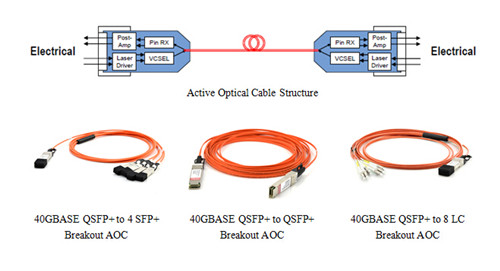Recently 40GbE is gradually becoming the dominant Ethernet in the data center, which greatly promote the popularity of 40G components, especially 40G optical transceivers and 40G QSFP+ cables. 40G optical devices, featured by its unique specification, are designed to meet different interconnection applications in data center. It is known that 40G copper direct attach cables (Copper DAC), 40G Active Optical Cables (AOCs) and 40GBASE-SR4 QSFP+ optics are used in data center to achieve 40G interconnection. But according to IHS (a research company), 40G AOC won larger market share than the other two solutions in 2015 and the trend will keep going in 2016. So what makes it so popular in the data center? The following article will list several features of 40G AOC to give you a satisfying answer.

What Is 40G AOC?
Before we come to the advantages of 40G AOC, let’s first have a brief overview of the 40G AOC cables. 40G AOC, is mainly used for short-range multi-lane data communication and 40GbE interconnect applications. It is a type of active optical cable terminated with 40GBASE-QSFP+ on one end, while on the other end, it can be terminated with QSFP+ connector, SFP+ connector, LC, SC, FC, and ST connector etc. The following picture shows three common types of 40G AOC.
40G AOCs have great advantages over 40G copper DACs like lighter weight, high performance, low power consumption, low interconnection loss, EMI immunity and flexibility. What’s more, when transmission distance reaches above 7 meters, 40G DAC is unable to reach. Just like QFX-QSFP-DAC-3M that is Juniper QSFP+ to QSFP+ passive copper cable with a link length of 3m. SR4 modules can support the same link length as AOC over OM3 cable, but has a better performance. Thus it is hard to tell which one is better than the other. The following part will illustrate from the next aspects—cost, Insertion Loss & Return Loss, Four-Quadrant Test and Digital Diagnostic Monitoring (DDM) to give you an objective solution about this.
Cost
40G AOCs cost lower than SR4 modules and do not need to use with extra fiber patch cables. In particular, 40G breakout AOCs, such as 40GBASE QSFP+ to 4 x SFP+ or 40GBASE QSFP+ to 8 x LC AOCs are cost-effective solutions to achieve 40G migration. For example, QSFP-4X10G-AOC1M is Cisco QSFP+ to 4SFP+ Active Optical Cable for a link length of 1 m. In additional, using AOCs, there are no cleanliness issues in optical connector and there is no need to do termination plug and test when troubleshooting, which can help user save more time and money.
Insertion Loss & Return Loss
Under the same case of transmission distance, the repeatability and interchangeability performances of SR4 module interface are not good as 40G AOC. What’s more, when different fiber optic patch cables plug into the module, it will have the different insertion loss and return loss. Even for the same module, this issue is existed. Of course, the related metrics such as the testing eye pattern will have no significant changes so long as the variation in and conformed to the scope. In contrast, an AOC with good performance is more stable and has better swing performance than SR4 modules in this situation. The following table shows the result of the repeatability test of SR4 module. From the data, it is clear to see that the repeatability performance of SR4 module is not stable.
Four-Quadrant Test
The so called four-quadrant test is a testing under four combinations of input voltage and signal amplitude which are used to ensure the product to keep better performance even under the lowest and highest voltage and temperature situation. Four-quadrant test in wide temperature range is used to test the MTP/MPO interface and optical cable of AOC in order to ensure them not to be melted at a high temperature. Generally, the current products of AOC can all satisfy this demand. In addition, as an integration product, the performance of AOCs is more stable than SR4 modules which should be used with indeterminacy-performance MTP/MPO connectors. Unlike SR4 module, the quality index of AOCs is judged by electric eye pattern but not by light eye pattern.
Digital Diagnostic Monitoring (DDM)
DDM can help end users to monitor real-time parameters of the modules. Such parameters include optical output power, optical input power, temperature, laser bias current, and transceiver supply voltage etc. 40GBASE-SR4 QSFP+ modules with DDM function can ensure it’s optimal coupling by the ADC (analog to digital converters) value of real-time monitoring receiver when receive coupling. Thus, SR4 modules have better receiving sensitivity than AOC. However, at present, both SR4 module and AOC can not reach the function of real-time power monitoring.
Conclusion
To sum up, AOCs can avoid the influence of environment and vibration with integration and sealed design. Compared with 40G AOCs, DAC cables are more easier to manage as users do not need to do a series of termination plug and test on-site, but they do when using SR4 modules and patch cables. Fiberstore provides many AOC products such as 10G SFP+ AOCs, 40G QSFP+ AOCs, QSFP+ to 4 SFP+ AOCs, and QSFP+ to 8 x LC AOCs. In addition, customized active optical cables are available in various lengths.
评论
发表评论